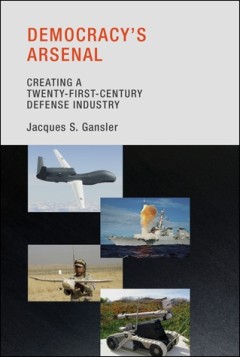Filter by

Bordieuan Field Theory as an Instrument for Military Operational Analysis
This book is open access under a CC BY 4.0 license. This book uses Pierre Bourdieu’s field theory as a lens through which to examine military operations. Novel in its approach, this innovative text provides a better, more nuanced understanding of the modern ‘battlespace’, particularly in instances of prolonged low-intensity conflict. Formed in two parts, this book primarily explores th…
- Edition
- 1
- ISBN/ISSN
- 978-3-319-65352-5
- Collation
- -
- Series Title
- New Security Challenges
- Call Number
- XV, 123

NL ARMS Netherlands Annual Review of Military Studies 2021
- Edition
- 1
- ISBN/ISSN
- 978-94-6265-471-6
- Collation
- -
- Series Title
- NL ARMS
- Call Number
- XI, 309
- Edition
- 1
- ISBN/ISSN
- 978-94-6265-471-6
- Collation
- -
- Series Title
- NL ARMS
- Call Number
- XI, 309

Procurement and Politics
- Edition
- -
- ISBN/ISSN
- 9783031256899
- Collation
- -
- Series Title
- -
- Call Number
- -
- Edition
- -
- ISBN/ISSN
- 9783031256899
- Collation
- -
- Series Title
- -
- Call Number
- -

Russia-China Relations
This open access book examines Russia-China relations across a variety of civilian and military areas of cooperation. Leading experts in the field present empirical case studies covering a wide range of strategic cooperation areas between Russia and China, such as technological, military, economic and political cooperation. The contributing authors shed new light on Chinese and Russian strategi…
- Edition
- -
- ISBN/ISSN
- 978-3-030-97012-3
- Collation
- -
- Series Title
- -
- Call Number
- -

Innovation in Bayern
Dieses Open-Access-Buch befasst sich mit der Einstellung der bayerischen Militärführung in Hinblick auf die Rezeption als auch Adaption technischer Innovation bzw. deren ersten praktischen Anwendung im Krieg von 1866. Das 19. Jahrhundert stellte das bayerische Königreich vor mehrere Herausforderungen. Die militärische Partizipation an den Napoleonischen Kriegen endete zwar erfolgreich…
- Edition
- 1
- ISBN/ISSN
- 978-3-658-39561-2
- Collation
- -
- Series Title
- -
- Call Number
- VI, 311

Street Riot Drill and Sword Exercise
The formations used in this drill were devised by Lieutenant W. F. Fulhim, U. S. Xavy. Some of the battalion movements were based upon the work of the late General Brownell X. GS. X. Y. The company movements are new. They are of special value, because, in dispersing a mob, it may at times be wise to assign each company of a battalion to a separate street with orders for all to rendezvous later …
- Edition
- -
- ISBN/ISSN
- -
- Collation
- 27 p. 15 cm,
- Series Title
- -
- Call Number
- -

Innovation in Bayern
- Edition
- 1
- ISBN/ISSN
- 978-3-658-39561-2
- Collation
- -
- Series Title
- 4 b/w illustrations, 8 illustrations in colour
- Call Number
- 978-3-658-39561-2
- Edition
- 1
- ISBN/ISSN
- 978-3-658-39561-2
- Collation
- -
- Series Title
- 4 b/w illustrations, 8 illustrations in colour
- Call Number
- 978-3-658-39561-2

Democracy's Arsenal: Creating a Twenty-First-Century Defense Industry
The author describes the transformations needed in government and industry to achieve a new, more effective system of national defense.OCLC-licensed vendor bibliographic record.
- Edition
- -
- ISBN/ISSN
- 9780262295260
- Collation
- 1 online resource (xiv, 432 pages) :illustrations
- Series Title
- -
- Call Number
- -

The heirs of Archimedes : science and the art of war through the Age of Enlig…
Essays analyze the connections between science and technology and military power in the late medieval, Renaissance, and Enlightenment periods.The integration of scientific knowledge and military power began long before the Manhattan Project. In the third century BC, Archimedes was renowned for his research in mechanics and mathematics as well as for his design and coordination of defensive sieg…
- Edition
- -
- ISBN/ISSN
- 9780262284226
- Collation
- 1 online resource (vi, 397 pages) : illustrations.
- Series Title
- Dibner Institute Studies in the History of Science and Technology
- Call Number
- 500 STE h

Perspectives on Defense Systems Analysis
"The Department of Defense and the military continually grapple with complex scientific, engineering, and technological problems. Defense systems analysis offers a way to reach a clearer understanding of how to approach and think about complex problems. It guides analysts in defining the question, capturing previous work in the area, assessing the principal issues, and understanding how they ar…
- Edition
- -
- ISBN/ISSN
- 9780262330244
- Collation
- 1 online resource.
- Series Title
- -
- Call Number
- -
 Computer Science, Information & General Works
Computer Science, Information & General Works  Philosophy & Psychology
Philosophy & Psychology  Religion
Religion  Social Sciences
Social Sciences  Language
Language  Pure Science
Pure Science  Applied Sciences
Applied Sciences  Art & Recreation
Art & Recreation  Literature
Literature  History & Geography
History & Geography